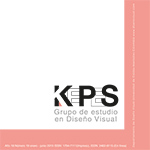Authors
Abstract
Science has been understood as the evidence of the rationality of Western culture and the Science Museum as the space where that image of rationality is publicly exposed. From the conception of the museum as a public institution until today, the cultural imaginaries of Science have evolved and, consequently, spaces for their representation have also changed. Therefore, the following analysis takes the exhibition space as a unit of study since when both, content and audience, converge on it, it is the place in which the imaginary is composed on what is exposed, either by what is proposed from its design or by the interpretation obtained when interacting in it. Three exhibition spaces will be projected at the Science museum and, although they have emerged and supposedly have being replaced by different circumstances and historical perceptions of the museum, today they are superposed and coexist in a large part of these institutions: the treasure cave, the department store and the creative studio. Understanding these typologies will allow distinguishing the role played by this institution in the divulgation and dissemination of science to society, in addition to the different cultural perceptions that have been inoculated from Science.
References
Bradburne, J. (1990). Beyond Hands-On: Truth-telling and the Doing of Science. En R. Glanville and G. de Zeeuw (Eds.), Mutual Uses of Science and Cybernetics (pp. 53-61). Amsterdam, Netherlands: Thesis Publishers.
Bradburne, J. (1998). Dinosaurs and white elephants: The science center in the 21st century. Museum Management and Curatorship, 17 (2), 119-137.
Davies, S. (2013). Constituting Public Engagement: Meanings and Genealogies of PEST in Two U.K. Studies. Science Communication, 35 (6), 687-707.
Durant, J. (1999). Participatory technology assessment and the democratic model of the public understanding of science. Science and Public Policy, 26 (5), 313–319.
Franco-Avellaneda, M. (2013). Museos, artefactos y sociedad: ¿cómo se configura su dimensión educativa? Universitas Humanística, 76, 97-123.
Hernández, F. y Rubio, X. (2009). Interactividad didáctica y museos. Enseñanza de las Ciencias Sociales, 8, 91-96.
Jiménez, S. y Palacio, M. (2010). Comunicación de la ciencia y la tecnología en museos y centros interactivos de la ciudad de Medellín. Universitas Humanística, 69, 227-257.
Klemmer, S.R., Hartmann, B. and Takayama, L. (2006). How bodies matters: Five themes for interaction design (pp. 140-149). En AMC, DIS ’06 Proceedings of the 6th conference. New York, USA: ACM Digital Library.
Labandeira, S. (2008). Breve recorrido por la evolución del concepto museo. Revista Museo, 13, 320-325.
Lipman, M. (1997). Pensamiento complejo y educación. Madrid, España: Ediciones de la Torre.
Lipovetsky, G. (1986). La era del vacío: ensayos sobre el individualismo contemporáneo. Barcelona, España: Anagrama.
Lozano, M. (2005). Programas y experiencias en popularización de la ciencia y la tecnología. Panorámica desde los países del Convenio Andrés Bello. Bogotá, Colombia: Convenio Andrés Bello.
McLuhan, M. (1996). Comprender los medios de comunicación: las extensiones del ser humano. Barcelona, España: Paidós.
McManus, P. (1992). Topics in Museums and Science Education. Studies in Science Education, 20 (1), 157-182.
Nussbaum, M. (2010). Sin fines de lucro. Por qué la democracia necesita de las humanidades. Madrid, España: Katz.
Oppenheimer, F. (1968). Rationale for a Science Museum. Curator: The Museum Journal, 1 (3), 206-209.
Orozco, G. (2005). Los museos interactivos como mediadores pedagógicos. Sinéctica, Revista Electrónica de Educación, 26, 38-50.
Pastor, I. (2011). Pedagogía museística. Nuevas perspectivas y tendencias actuales. Barcelona, España: Ariel.
Pedretti, E. (2002). T. Kuhn Meets T. Rex: Critical Conversations and New Directions in Science Centers and Science Museums. Studies in Science Education, 37 (1), 1-41.
Poulot, D. (2011). Museo y museología. Madrid, España: Abada Editores.
Rennie, L. (2007). Learning science outside of school. En S.K. Abell and N.G. Lederman (Eds.), Handbook of Research on Science Education. New Jersey, USA: Routledge.
Rousseau, J.-J. (1982). Emilio. Madrid, España: EDAF.
Vélez, C. (2013). De los ojos a las manos: tocar el espacio. El espacio táctil en la arquitectura moderna. Medellín, Colombia: Universidad Nacional de Colombia.
Wellington, J.J. (1998). Interactive science centers and science education. Croner’s Heads of Science Bulletin, 16.

 PDF (Español)
PDF (Español)
 FLIP
FLIP






















